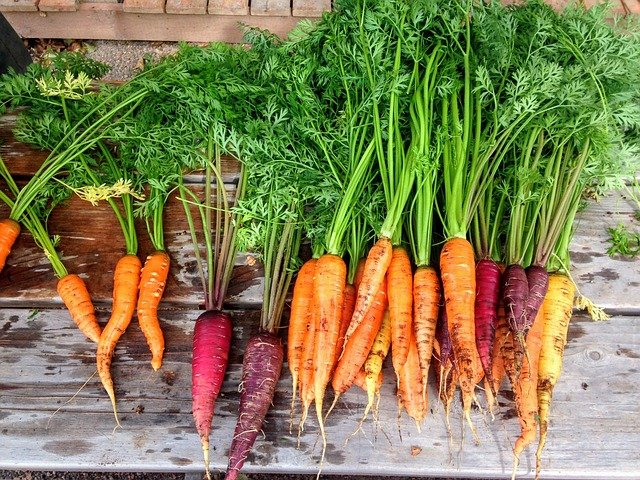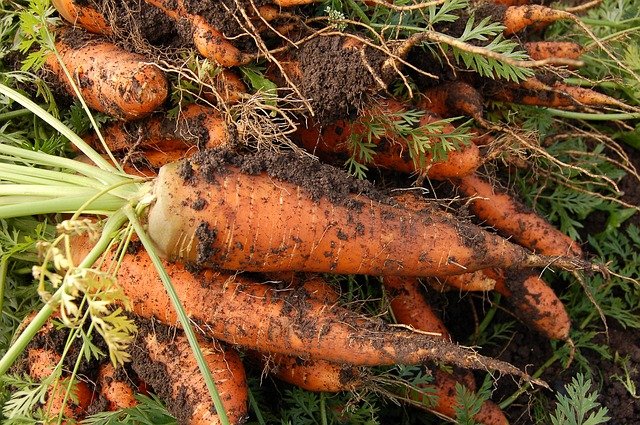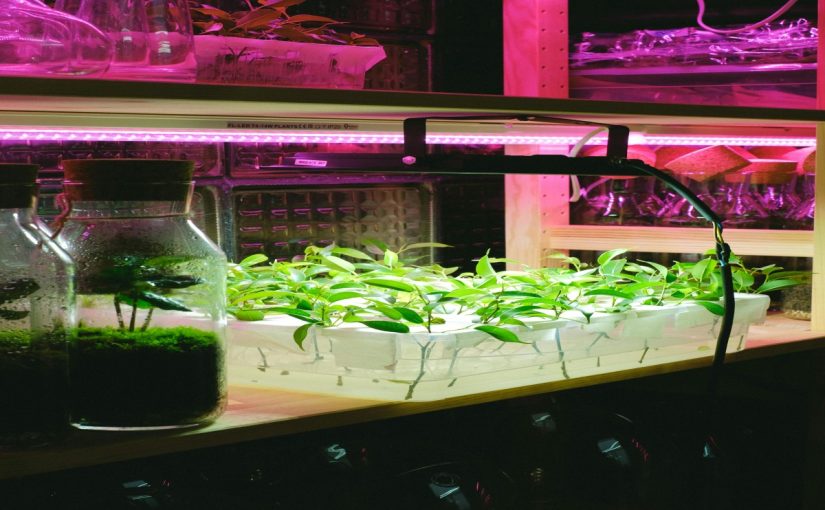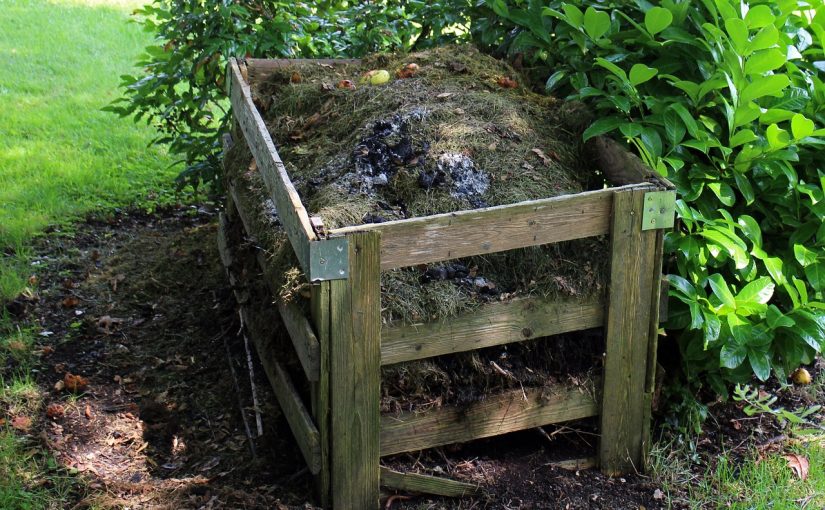Carrots are a member of the Apiaceae family. This family generally includes celery, dill, cilantro, and anise. These are biennial crops and produce taproots in their first year of carrot farming. These taproots are consumed by people. Further, if they are not taken out and left to grow in the ground, they flower and produce seeds and then die in the second year.
Carrot farming is quite lucrative and its benefits vary with variety and place of production.
The botanical name of carrot is Daucus carota.
All carrots can be consumed from the root to its tip. They can be found in various rainbow colors like red, orange, purple, or yellow. Leaves of carrots can also be used in salads. They are loaded with flavor and texture. They are very popular and versatile. Plus, it is a long-lasting root vegetable
In the U.S. mostly orange colored carrots are found. They are consumed fresh and can be stored for some time. This vegetable ranked 6th most eaten vegetable in theU.S. in 1997. Its consumption was recorded as 14.1 pounds per person. However, till 2015 its consumption lowered down to 9.31 pounds.
Different types of carrots?
Carrots are available in different colors, shapes, and sizes.
Based on shape, they are divided into 5 types.
- Danvers – this is the most commonly known carrot variety. It is long, slender, and tapers at the end. This variety is named after a place of growth i.e. Danvers. They are mostly found in orange color but are available in other shades too. As compared to other carrot types, they can easily tolerate poor soil.
- Nantes- this variety is round at the top and cylindrical. They have very few green tops and crunchy taste. The sweetness of this variety makes it delicious to eat. This carrot type grows faster than other types of carrots. Around 40 varieties fall into this type.
- Imperator- this carrot variety is most commonly found in the U.S. It looks similar to a danver but is greater in width than Danvers. Sugar content is also higher in this variety. They have fast-growing tops.
- Chantenay- Before Nantes, this carrot variety was very popular for growth in heavy and clayey soil. They grow up to 6-7 inches and tops grow very fast.
- Ball or mini- these carrots are small in size as the name suggests. Due to their short size or shallow roots, they are perfect for containers. The size of carrots ranges between 3-4 inches.

Varieties of carrots
Some commonly used varies of carrots are-
- Bolero- This variety of carrot is slightly tapered. It grows up to 7-8 inches. They can resist leaf pests and blights. Therefore, they can be easily grown in areas that suffer from this problem.
- Danvers -This variety is a classic heirloom. The size of this variety varies from 6-8 inches. They taper at the end too. Danvers can grow in heavy soil and are rich in texture and have an orange color.
- Littlefinger- little fingers are heirlooms and are small Nantes. They only go up to 4 inches in height. Growth of this variety can be easily carried out in containers.
- Nantes- these cylindrical carrots grow up to 6-7 inches. They are sweet and have a crisp texture.
- Thumbelina- these carrots have a round shape and grow well in clayey soil. Containers are also suitable for thumberline production.
Carrot growing season
Carrots are cool-season crops. They can grow perfectly in temperatures ranging from 18-21C. This temperature range provides edible roots optimum color.
Carrots are grown in loose or sandy soil. Growing in such kind of soil provides enough room for roots to expand without any restrictions. Keep in mind that any root or soil clumps should be completely removed from the planting site. They grow well in cool seasons. The best time to grow carrots in spring or fall.
It takes around 2-4 months for carrots to fully mature. You Can keep planting carrots in spring and summer after every 3 weeks to get a continuous supply of carrot still cold frosts hit.
In the U.S. for fresh carrot farming, the gross value is $10600 per acre. This value may vary with the area and merchandise level.
What should be the soil condition for carrot farming?
As mentioned earlier, the soil should be loose and sandy for letting carrots to grow fully. If soil is not good then carrots may face stunted growth.
Soil can be cleared up to 12 inches in depth. Remove rocks, pebbles, soil clumps, or any other plant roots from soil to provide a clean and free area to grow.
Do not add fertilizers that have nitrogen in them. It leads to forking in carrots and the growth of side roots too.
Grow carrots in older coffee grounds for getting nutrients from the soil.
If the soil on the planting site is clayey or heavy then cover it with 12-inch deep sandy soil. Then you can carry out carrot farming on it. You can also use airy, loamy soil for the same.
If soil is heavy, compact, and overly packed with nutrients like nitrogen then it leads to misshapen carrot production. They are not quite fit for consumption.
When to plant carrots?
For harvest in summer, you should sow seeds at least 3-5 weeks before the last spring frost date. There is various software available to check frost dates in your area.
Keep sowing seeds every 3 weeks to harvest carrots continuously later on.
For harvesting in the fall, you can sow seeds in mid of summer end. You can begin showing 10 weeks before the first frost.
For sowing seeds, you must prepare your planting site. The soil must be favorable for carrot farming. It should be loose, airy, loamy, and sandy for carrot farming. The planting area should receive full sunlight. However, carrots can survive in partial shade too.
Also Read: Turnip Farming Information Guide
How to plant carrots?
Rather than sowing seeds in containers first and then transplanting, start sowing directly into the soil. Carrots do not like to get their delicate roots disturbed. Therefore, it is better to place them in soil and do not disturb them till harvesting.
While sowing seeds, sow them in ¼ inch deep holes. Keep them around 2-3 inches apart in 1 feet rows.
Distribute seeds evenly to get a good harvest at the end. Scatter them here and there will not ensure properly and fully grown carrots. They might face competition from each other.
Further, the soil should be moist but not wet. Keep adding shallow waterings regularly. A crusted soil top is not favorable for the germination of small carrots. To avoid this condition, cover the top of the soil with a vermiculite or compost layer. It keeps the soil moist and doesn’t let the crust form.
It takes around 2-3 weeks for germination. Carrots germinate slowly so many gardens prefer sowing radish along. Radish is ready to harvest in a very small time. To speed up germination on carrots you can perform a damp paper towel method. That allows seeds to sprout before being sewed into the soil.
The adequate temperature for seed germination is 50-85F. It can germinate at low temperatures up to 40F and as high as 75F if it is provided with adequate moisture. Seeds can be stored and used for 3 years.
Care Of Carrots
To keep carrots weed-free and healthy, mulch can be used. It helps in retaining moisture in the soil and suppresses weeds too. Also, germination speeds up if mulch is used. It also blocks sunlight from falling directly on roots and damaging them.
The thinning of carrots can also be performed when they grow about 1 inch tall. Thin carrots so that they stay at least 3-4 inches apart and do not become crowded.
For better growth, snip tops of carrots using scissors rather than pulling.
Providing a proper amount of water is crucial in the growth of carrots. They need moisturized soil but it should not be too wet. Wet soil can lead to diseases and even cause the death of plants. Water up to 1inch per acre per week. When carrots mature, water can be increased by up to 2 inches per acre.
Nitrogen is harmful to carrots so avoid nitrogen fertilizer use. Instead, high potassium and phosphorus fertilizers can be used after 5-6 weeks of sowing. This ensures nutrition for carrots.

Must Read: Rabbit farming: How to Start Raising Rabbits
Harvesting Carrot production
When harvesting, know that smaller carrots taste better than larger ones. They can be harvested after 60-80 days of sowing seeds.
When to harvest carrots?
Carrots are ready to harvest when they reach at least ½ inch in diameter size. If the growth of carrots was carried out in spring or early summer then harvest them before it gets too hot. Heat sends signals to carrots to make their roots more fibrous. This condition can make them a little nonedible.
Moisten your soil a little to ease out pulling carrots while harvesting.
In fall harvest, wait for the first fall frost before harvesting your crop. Cover soil with about an 18 inch leaves layer. After frost, pull out your carrots. The reason behind this is, frost tends to force carrots to store energy in roots. Energy is stored in the form of sugars. Hence, your carrots become sweeter at this time.
Do not wash your carrots if you are not going to use them next week.

How do you know when carrots are ready to pick?
Tops of carrots start popping out of the ground sometimes and it is a clear indication that they are ready to harvest. Their tops can be around ¾ inch to 1 inch in diameter. Moreover, its color is vibrant.
If carrot tops are not bulging out themselves, remove some soil from their sides, and check their condition.
Generally, this happens around 60-80 days after sowing seeds.
Storage of carrots
Cut the greens of the carrots but leave 1/2 inch of it attached to the carrots. It is necessary to remove greens otherwise they will extract all sugars away from carrots.
Wash carrots with cold water remove all dirt from them. Seal them in airtight plastic bags after air drying and store them in the refrigerator. If you leave them just as it is they will limp soon.
Carrots can be stored in a cool and dry area. You can also fill up a place with dry sawdust and store carrots in it.
Pest and diseases in carrots
Carrot rust flies, flea beetles, black canker, root-knot nematodes, and wireworms can easily infect and feed on carrot production.
Nematodes have a very vast host range and too much infection of carrots can make them unfit for cultivation.
After yellow disease, carrots produced are short and have discolored tops with roots very hairy. Leafhoppers move from one plant to another and lead to this disease. No treatment or control strategy is available for this disease.
Health benefits of carrots
Half cup of carrots has the following nutrition-
25 calories, 2g of fiber, 6g of carbohydrates, 0.5g of proteins.
Half cup of carrots has the following amount of vitamins and minerals-
73% of the daily requirement of vitamin A
9% of the daily requirement of vitamin K
8% of the daily requirement of potassium and fiber content
5% of the daily requirement of vitamin C
2% of the daily requirement of iron and calcium
Also, it has beta carotene and vitamin A which is good for the eyes.
It also aids in lowering down the risk of cancer. Antioxidants present in carrots fight with harmful radicals in the body. Carotenoids and anthocyanins are the main antioxidants present in carrots.
Heart diseases can be prevented by carrot consumption. Antioxidants are good for health and potassium keeps blood pressure in check.
Conclusion
Carrot farming can be easily carried out by taking care of basic things. They have very high and regular demand. The growth of carrots is easy and therefore, it can be a profitable business for you. The yield of carrots varies depending on the variety that you choose. So, check out varieties that grow well in your area and provide profits at the same time and then begin.
References:
http://www.carrotmuseum.co.uk/historyusa.html
https://www.agmrc.org/commodities-products/vegetables/carrots



